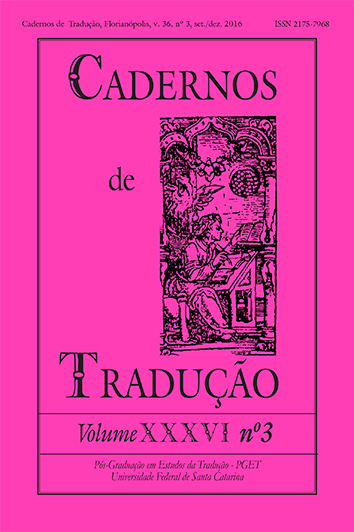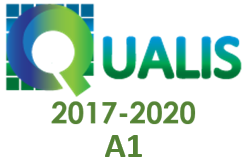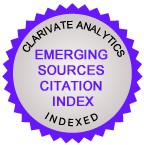Cognitive effort in direct and inverse translation performance: Insight from eye-tracking technology
DOI:
https://doi.org/10.5007/2175-7968.2016v36n3p60Abstract
This case study examined the translation performance of four professional translators with the aim of exploring the cognitive effort involved in direct and inverse translation. Four professional translators translated two comparable texts from English into Spanish and from Spanish into English. Eye-tracking technology was used to analyze the total time spent in each task, fixation time, and average fixation time. Fixation count in three areas of interest was measured including: source text, target text, and browser, used as an external support. Results suggested that although total time and fixation count were indicators of cognitive effort during the tasks, fixation count in the areas of interest data showed that more effort was directed toward the source text in both tasks. Overall, this study demonstrates that while more traditional measures for translation difficulty (e.g., total time) indicate more effort in the inverse translation task, eye-tracking data indicate that differences in the effort applied in both directions must be carefully analyzed, mostly regarding the areas of interest.
References
Alves, Fabio, and José Luiz Gonçalves. "Investigating the Conceptual-Procedural Distinction in the Translation Process: A Relevance-Theoretic Analysis of Micro and Macro Translation Units." Target 25.1 (2013): 107-124.
Buchweitz, Augusto, and Fabio Alves. “Cognitive Adaptation in Translation: An Interface between Language Direction, Time, and Recursiveness in Target Text Production.” Letras de Hoje 41 (2006): 241– 272.
Carl, Michael, and Barbara Dragsted. Inside the Monitor Model: Processes of Default and Challenged Translation Production. TC3, Translation: Computation, Corpora, Cognition, 2.1 (2012): 127-145.
Dragsted, Barbara. “Coordination of reading and writing processes in translation: An eye on uncharted territory.” Translation and Cognition. Ed. Gregory M. Shreve and Erik Angelone. Amsterdam/Philadephia: John Benjamins Publishing. 2010. 41-62.
Ehrensberger-Dow, Maureen, Birgitta Englund Dimitrova, Séverine Hubscher-Davidson, and Norberg, Ulf. Describing Cognitive Processes in Translation: Acts and events. Special Issue of Translation and Interpreting Studies, 8. 2 (2012): 151-153.
Feltrin-Morris, Marella. Into forbidden territory: The audacity to translate into a second language. Diss. State University of New York, 2008. Ferreira, Aline. “Investigando o Processamento Cognitivo de Tradutores Profissionais em Tradução Direta e Inversa no Par Linguístico Inglês-Português.” Cadernos de Tradução 1 (2012): 73–92.
Ferreira, Aline. Analyzing recursiveness patterns and retrospective protocols of professional translators in L1 and L2 translation tasks. Translation and Interpreting Studies, 9.1 (2014) 109-127. Amsterdam/Philadelphia: John Benjamins Publishing.
Ferreira, Aline, John. W. Schwieter, and Daniel Gile. “The position of psycholinguistic and cognitive science in translation and interpreting: An introduction.” Psycholinguistic and cognitive inquiries into translation and interpreting. Ed. Aline Ferreira and John W. Schwieter. Amsterdam: John Benjamins Publishing, 2015. 3.15.
Ferreira, Aline, and John W. Schwieter. Directionality in translation. The Handbook of Translation and Cognition. Ed. John W. Schwieter and Aline Ferreira. Malden, MA/Oxford, England: Wiley-Blackwell.
Gollan, Tamar, Rosa I. Montoya, and Werner, Grace A. Semantic and letter fluency in Spanish-English bilinguals. Neuropsychology, 16.4 (2002): 562–576.
Hvelplund, Kristian T. Allocation of cognitive resources in translation: An eyetracking and key-logging study. Diss. Copenhagen Business School, 2011.
Hvelplund, Kristian T. Eye tracking and the translation process: Reflections on the analysis and interpretation of eye-tracking data. MonTI - Special Issue on Cognitivism and Translation. Ed. Ricardo Muñoz Martín. Alicante: Universidad de Alicante, 2014. 201-223.
Isacoff, Nora M., and Stromswold, Karin. “Not All Verbal Fluency Tasks Are Created Equal: Lexical Access development between three and five.” First Language 34.1 (2014): 43-57.
Jakobsen, Arnt Lykke, and Lasse Schou. "Translog Documentation." Probing the Process in Translation. Methods and Results. Ed. Gyde Hansen. Copenhagen: Samfundslitteratur. 1999. Appendix, 1-6.
Just, Marcel A., and Patricia A. Carpenter. “A theory of reading: From eye fixations to comprehension.” Psychological Review 87.4 (1980): 329-354.
Ordoñez López, Maria del Pilar. 2010. “De mayor quiero ser traductor. Estudio de las preconcepciones de los alumnos de primer curso del Grado en Traducción e Interpretación.” Intralinea, 2010. Web. 21 Jul. 2016. <http://www.intralinea.org/archive/article/1659>
PACTE Group. “Results of the Validation of the PACTE Translation Competence Model: Translation Project and Dynamic Translation Index.” Cognitive Explorations of Translation.Sharon O’Brien. London: Continuum, 2011. 30-56.
Pavlović, Nataša, and Kristian Tangsgaard Hvelplund Jensen. "Eye tracking translation directionality." Translation Research Projects. Ed. Anthony Pym and Alexander Perekrestenko. Tarragona: Universitat Rovira i Virgili. 2009. 101-119.
Schwieter, John W., and Aline Ferreira, Eds). The development of translation competence: Theories and methodologies from psycholinguistics and cognitive science. Newcastle, England: Cambridge Scholars, 2014.
Shreve, Gregory, and Erik Angelone. (eds). Translation and cognition. Amsterdam: John Benjamins, 2010.
Taboada, Maite, and William C. Mann. “Rhetorical Structure Theory: Looking Back and Moving Ahead.” Discourse Studies 8. 3 (2006): 423-459.
Downloads
Published
How to Cite
Issue
Section
License
Copyright Notice
Authors hold the copyright and grant the journal the right for their articles' first publication, being their works simultaneously licensed under the Creative Commons Attribution License (CC BY), which allows the sharing of such works with its authorship acknowledged and its initial publication in this journal.
Authors are allowed to enter into separate additional contractual arrangements for the non-exclusive distribution of the journal's published version of the work (e.g., post it to an institutional repository or as a book chapter, with an acknowledgment of its initial publication in this journal).






















































